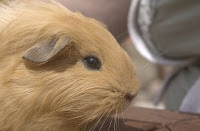The next morning the Belgian car comes around to the hotel again, this time with Hugo, regional agent for CTB and another Belgian volunteer. We are off to an association of women farming guinea pig as well as a mixed group of guinea pig farmers in Guayacondo.
Don't think pets or ~ as their name implies ~ animals being used to test drugs. In Peru guinea pigs (cuyes) are...dinner. Yuk, rodent, but guinea pig is considered a delicacy around here. The country consumes some 65 million guinea pigs per year. Native to the region and bred in captivity since time immemorial, it is widely used in the Andean region as a food source for low-income families as it is rich in protein. Beyond its nutritional value 'el cuy' also has economic and social significance in the rural areas of Peru. Guinea pig breeding provides women farmers with an opportunity to contribute to family income, which adds to food security and strengthens their position within the family (read = reduces violence).
 Hugo explains that CTB, in collaboration with other NGOs and the Agriculture Ministry, supports a food security program, which provides individuals with 1 male and 7 female guinea pigs ~ they breed fast ~ as well as training in state-of-the-art feeding (alfa alfa, corn leaves and kitchen scraps) and breeding techniques.As a result, these communities are now self-sustaining. They are able to support the high demand for guinea pig in the Ayachuco region, selling to Ayacucho hotels, restaurants and local markets. Guinea pig trade is particularly fierce around Christmas time and leading up to any of the holidays.
Hugo explains that CTB, in collaboration with other NGOs and the Agriculture Ministry, supports a food security program, which provides individuals with 1 male and 7 female guinea pigs ~ they breed fast ~ as well as training in state-of-the-art feeding (alfa alfa, corn leaves and kitchen scraps) and breeding techniques.As a result, these communities are now self-sustaining. They are able to support the high demand for guinea pig in the Ayachuco region, selling to Ayacucho hotels, restaurants and local markets. Guinea pig trade is particularly fierce around Christmas time and leading up to any of the holidays. |
| some rights reserved MJames |
But the disappointment has a silver lining. When I go online to search for a guinea pic, I learn that guinea pig poop is being turned into electricity! Perhaps old news to some, but to me it's part of pretty cool sustainable farming practices in the Andes. www.boingboing.net/2010/09/05/adorable-alternative.html
--------------------------------------------------------------------------------------------------------
The Belgian volunteer and I return to the hotel for lunch during which we are visited by Tania, a woman entrepreneur who runs a handicraft association called Manosunidas (United hands), a group of Mujeres Artisanas ~ women producing handicrafts ~ from a town called Tocos. Tania shows me an extensive catalog and also promises to bring a video to the bus depot before I head back to Lima later that evening.
In an earlier phase, Manosunidas received design and production support from CTB, but they are ~ or need to be ~ self-sustaining these days. Manosunidas sells its products through intermediaries, but Tania isn't particularly happy with the prices she receives. I ask her if they supply products to Sumaq Qara, but she vigorously shakes her head and says she's not interested in doing business with them. Clearly not all associations see eye to eye in the region. Tania also talks of the difficulty of keeping the women from Tocos in work ~ a recurring pattern ~ and her desire to start trading direct.
Manosunidas has a website sporting their product line but does not deal with direct orders online. There is an atelier quite far away full of sample product, but alas there isn't enough time to visit as I am slated to meet Faustos (having cleared his legitimacy with Guillermo).
Run out of space again, so the afternoon trip up country will become the last of the Ayacucho blogs. Until then, a sampling of mannequins frequently used by artisan associations and local shops to show off their wares. For some reason they tickle my funny bone.

Manosunidas has a website sporting their product line but does not deal with direct orders online. There is an atelier quite far away full of sample product, but alas there isn't enough time to visit as I am slated to meet Faustos (having cleared his legitimacy with Guillermo).
Run out of space again, so the afternoon trip up country will become the last of the Ayacucho blogs. Until then, a sampling of mannequins frequently used by artisan associations and local shops to show off their wares. For some reason they tickle my funny bone.
 |
| grad gear anyone? |






